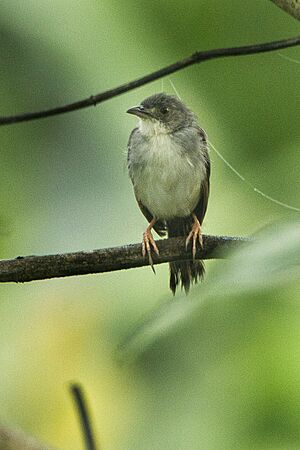Whistling cisticola facts for kids
Quick facts for kids Whistling cisticola |
|
|---|---|
 |
|
| In Ghana | |
| Conservation status | |
| Scientific classification | |
| Genus: |
Cisticola
|
| Species: |
lateralis
|
The whistling cisticola (Cisticola lateralis) is a small bird that belongs to the Cisticolidae family. You can find these birds in many parts of Africa. They live in countries like Angola, Ghana, Kenya, and Nigeria. Their favorite places to live are dry forests and savannas.
Contents
What is a Whistling Cisticola?
The whistling cisticola is a medium-sized bird. It measures about 13 to 16 centimeters long. Male birds usually weigh between 14 and 21 grams. Females are a bit lighter, weighing 12 to 19 grams.
How to Spot a Male Cisticola
When it's breeding season, male cisticolas have a special look. Their cheeks are gray-brown, and their head and belly are a dark, sooty-brown. Their tail is also gray-brown. Most of their body is dark brown, with some reddish-brown hints. Males often have a white throat and a black beak. Their legs are a dull pink color.
When males are not breeding, their feathers look a bit different. They become more reddish-brown. Their belly is a richer buff color, and their chest turns gray.
How to Spot a Female Cisticola
Female cisticolas usually have lighter colored feathers. Their beak is more brownish. They also have a more slender body shape compared to the males.
Young Cisticolas
Young cisticolas, called juveniles, are thinner than adult birds. They have a yellowish wash on their underside. Their beaks are brown with some yellow parts. Some young birds even have bright red underparts!
Different Types of Whistling Cisticolas
There are a few different types, or subspecies, of whistling cisticolas:
- Cisticola lateralis modestus
- Cisticola lateralis lateralis
- Cisticola lateralis antinorii
The antinorii type is a paler brown. It has a fluffier body. Its feathers don't change with the seasons. The modestus type is smaller. It has more red in its feathers. Its head is gray-brown.
Where Do Whistling Cisticolas Live?
These birds live across a very large area in Africa. Their numbers seem to be steady, which is good news! This means they are not currently in danger of disappearing.
Where Each Subspecies Lives
- The antinorii subspecies lives from the Central African Republic to West Kenya.
- The lateralis subspecies can be found from Senegambia to Nigeria and Cameroon.
- The modestus subspecies lives from Gabon to North Angola and the South Democratic Republic of Congo.
What Do Whistling Cisticolas Eat?
Whistling cisticolas mainly eat different kinds of insects. They also eat small creatures without backbones, called invertebrates. Their diet includes:
They usually hunt for food in family groups. It's rare to see one hunting alone. These groups find food on or near the ground. They get all the nutrients they need from plants and the creatures living on them.
Reproduction and Life Cycle
Male whistling cisticolas can have more than one mate. However, they like to have their own space for breeding. They will sing from high spots where females can easily see them. Sometimes, they even do special display flights!
Nest Building
Female cisticolas are very good at building hidden nests. Their nests are often oval-shaped. They have a small entrance on the side. The nests are made from dry grass and living leaves. The birds use spiderwebs to hold everything together. They also add extra leaves on top to help hide the nest. A typical nest is built about 0.2 to 0.6 meters above the ground.
Eggs and Chicks
A female cisticola usually lays about 2 to 3 eggs at a time. Both the male and female parents help feed the baby chicks once they hatch.


